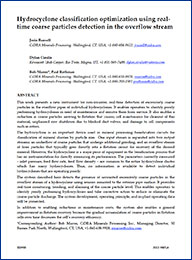2013 Mapla • Hydrocyclone Classification Optimization
Hydrocyclone Classification Optimization Using Realtime Coarse Particles Detection in the Overflow Stream
This work presents a new instrument for non‐invasive, real‐time detection of excessively coarse particles in the overflow pipes of individual hydrocyclones. It enables operators to identify poorly performing hydrocyclones in need of maintenance and remove them from service. It also enables a reduction in coarse particles arriving to flotation that causes; cell maintenance for cleanout of this material, unplanned row shutdown due to blocked dart valves, and damage to cell components such as rotors.
The hydrocyclone is an important device used in mineral processing beneficiation circuits for classification of mineral slurries by particle size. One input stream is separated into two output streams; an underflow of coarse particles that undergo additional grinding, and an overflow stream of finer particles that typically goes directly into a flotation circuit for recovery of the desired mineral. However, the hydrocyclone is a major piece of equipment in the beneficiation process that has no instrumentation for directly measuring its performance. The parameters currently measured –inlet pressure, feed flow rate, feed flow density – are common to the entire hydrocyclone cluster which has many hydrocyclones. Thus, no information is available to detect individual hydrocyclones that are operating poorly.
The system described here detects the presence of unwanted excessively coarse particles in the overflow stream of a hydrocyclone using sensors mounted to the exterior pipe surface. It provides real‐time monitoring, trending, and alarming of the coarse particle level. This enables operators to identify poorly performing hydrocyclones and take corrective action to reduce or eliminate the coarse particle discharge. The system development, operating principle, and in‐plant operating data will be presented.
In addition to enabling reductions in maintenance costs, the system also enables a general improvement in flotation recovery because the gradual accumulation of coarse particles in flotation cells over time decreases the cell’s recovery efficiency.

